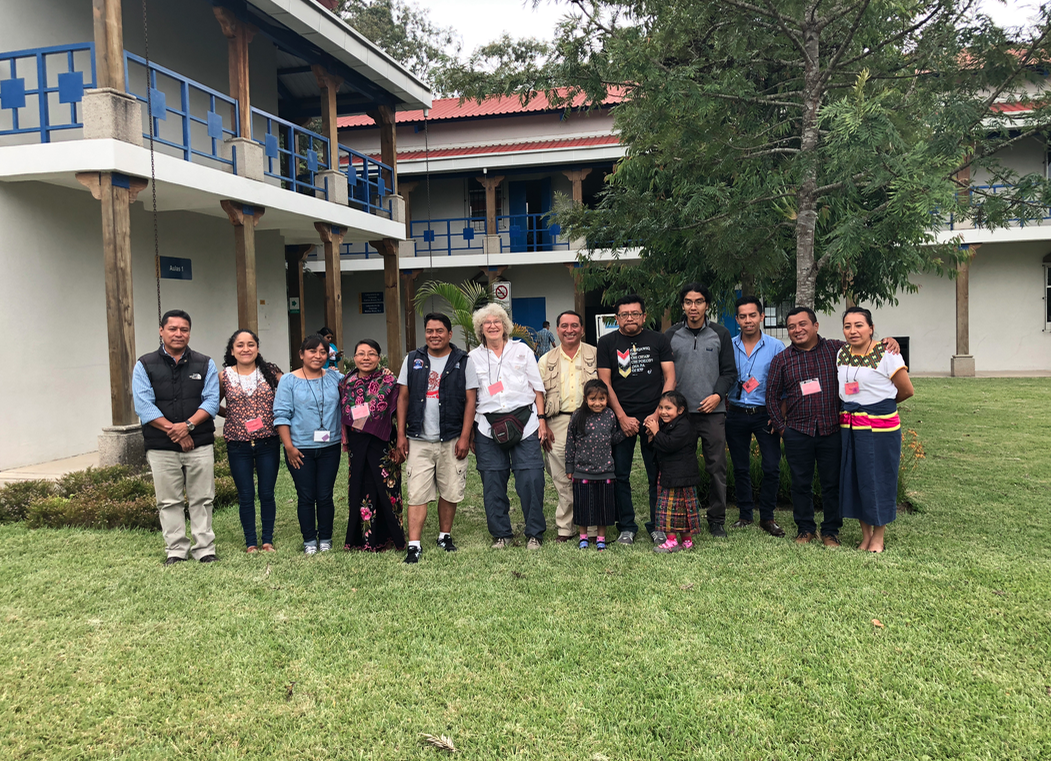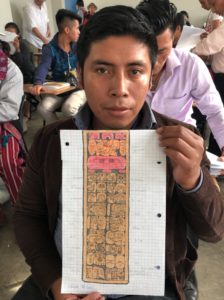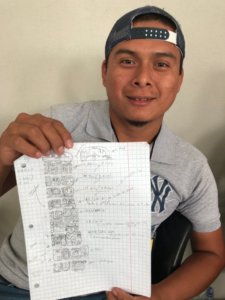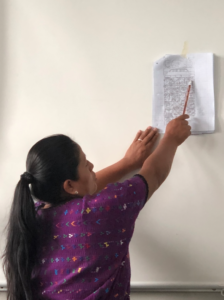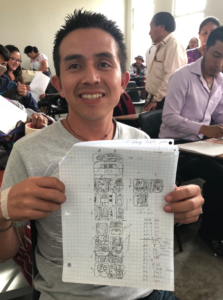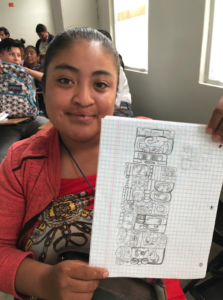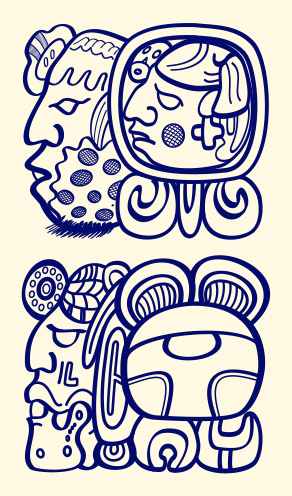
9 Ajaw 13 Sek. Drawing by Jorge Pérez de Lara.
Dear MAM Supporters,
Thank you all for your incredible support to help make the Fourth International Congreso on Ancient Maya Writing a great success!!
I am deeply humbled by your generosity, and your willingness to help return the Maya Hieroglyphic Script, the Ojer Maya Tz’ib’, to the Maya people. It was wonderful seeing so many familiar faces, and so many new ones in Huehuetenango, and I was honored to be a part of this historic event. In the beginner’s workshop, Christopher Powell and I were able to teach many people to read and write the Long Count, including the entire Lunar Series. To see the dedication and gratitude among so many Maya people is something I will never forget. The pride and artistry among these new scribes is immeasurable. They have all joined the ranks of the Aj Tziib’.
Thank you to Barbara MacLeod, Nick Hopkins, Christopher Powell and Gerardo Aldana for helping with the workshops and presentations, and thanks to Elaine and David Schele for all of their help and support, and for documenting this event with photos!
Special thanks to the Mam people, who hosted us in their homeland and graced us with their beautiful marimba music, to our host, Director Manrique Díaz from Rafael Landivar University, to the Proyecto Lingüistico Francisco Marroquin team, and the Academia de las Lenguas Mayas de Guatemala. Lastly, thanks to our donors Kelly and William Warren for joining us at the Congreso. It was truly an unforgettable experience for us all.
The following is the inaugural address I prepared for the opening ceremonies, which took place on July 2, 2018.
Thank you for your tireless support, and for your understanding the great value of our collective work.
Chjontexix, Maltyox, and Yum Bo’otik,
Michael J. Grofe, President
MAM
—
Inaugural Address
Michael J. Grofe, President
MAM
July 2, 2018
Thank you to our gracious hosts, and to the organizers of this historic event. Thanks to the PLFM Team, to:
Saqijix Lopez Ixcoy
Beatriz Par Sapóm
Ajpub’ Garcia Ixmata
Juan Guarchaj Tzep
Hector Rolando Xol
I would like to thank all of the participants who have traveled from near and far to gather here to learn and to teach.

9 Ajaw 13 Sek. Dibujo por Jorge Pérez de Lara.
Estimados partidarios de MAM,
¡Gracias a todos por su increíble apoyo para ayudar a que el Cuarto Congreso Internacional de Escritura Maya Antigua sea un gran éxito!
Estoy profundamente honrado por su generosidad y su disposición a ayudar a devolver el guión jeroglífico Maya, el Ojer Maya Tz’ib ‘, al pueblo Maya. Fue maravilloso ver tantas caras familiares, y tantas nuevas en Huehuetenango, y tuve el honor de ser parte de este evento histórico. En el taller para principiantes, Christopher Powell y yo pudimos enseñarle a mucha gente a leer y escribir la Cuenta larga, incluida toda la Serie Lunar. Ver la dedicación y la gratitud entre tanta gente maya es algo que nunca olvidaré. El orgullo y la maestría entre estos nuevos escribas es inconmensurable. Todos se han unido a las filas de Aj Tziib’.
¡Gracias a Barbara MacLeod, Nick Hopkins, Christopher Powell y Gerardo Aldana por ayudar con los talleres y presentaciones, y gracias a Elaine y David Schele por toda sus ayuda y apoyo, y por documentar este evento con fotos!
Un agradecimiento especial al pueblo Mam, que nos hospedó en su tierra natal y nos honró con su hermosa música de marimba, gracias a nuestro anfitrión, el Director Manrique Díaz de la Universidad Rafael Landivar, al equipo del Proyecto Lingüístico Francisco Marroquin y la Academia de Lenguas Mayas de Guatemala.
El siguiente es el discurso inaugural que preparé para las ceremonias de apertura, que tuvieron lugar el 2 de julio de 2018.
Gracias por su apoyo incansable y por su comprensión del gran valor de nuestro trabajo colectivo.
Chjontexix, Maltyox, and Yum Bo’otik,
Michael J. Grofe, Presidente
MAM
—
Discurso Inaugural
Michael J. Grofe, Presidente
MAM
2 de julio, 2018
Gracias a nuestros amables anfitriones y los organizadores de este histórico evento. Gracias al Equipo PLFM, a
Saqijix Lopez Ixcoy
Beatriz Par Sapóm
Ajpub ‘Garcia Ixmata
Juan Guarchaj Tzep
Hector Rolando Xol
Me gustaría agradecer a todos los participantes que han viajado de cerca y de lejos para reunirse aquí para aprender y enseñar.
Thanks to the beautiful people of Guatemala. You have been in our hearts as you mourn the loss of so many lives from Volcan de Fuego. May the anger of the Earth subside.
May all of the migrants be reunited with their children, and may we all live long and prosperous lives in peace as brothers and sisters on this Earth.
I would also like to thank the MAM Executive Committee:
Elaine Schele, who joins us with her husband David,
Beth Spencer,
and Susan Glenn.
Thanks to our former president Bruce Love, and to the MAM Board of Directors, and thanks to all of our supporters who donated so generously to make this possible.
Thanks to our donor, Dr. Kelly Warren, and his son William, who join us here.
I am both honored and humbled to be here. When I was elected president of MAM two years ago, I told Bruce Love that I didn’t know if I could do this. I was just starting my position as a full time professor, and fundraising was not one of my best skills. But he replied that the most important thing is that you care, and that your heart is in the right place. The rest will follow. He said that it is not about us and what we think we can’t do. It is about something much larger than ourselves, and what we can do, in whatever way we can help.
I do care deeply about our goal of returning the Maya hieroglyphic script to its rightful home among the Maya, among all of you, and I am so grateful to report that we ran a successful campaign this year at MAM to raise funds for this event. I am so glad that our supporters have generously stepped up to help support the good work that you all are doing.
Over the past two years, we have been able to fund approximately 15 mini-grants per year throughout the Mundo Maya, as well as several Pre-Congreso events, and we hope to continue to fund applicants in the future.
When I met with Ajpub’ García Ixmata and Juan Rodrigo Guarchaj Tzep this past January, they asked that together we come up with a theme for this Fourth International Congreso on Ancient Maya Writing, Ojer Maya’ Tz’iib’. They also asked that we bring some epigraphers to present their own research, and to help facilitate the workshops. Given my own interest in archaeoastronomy, I proposed that the theme be “Creation and Astronomy,” and they agreed. While this is not an exclusive theme, I am happy to contribute what I can.
I was lucky to have my father first teach me about the stars from when I was a young boy. He was a sailor.
I’m not a sailor… (Yo no soy marinero…)
Neither am I a captain.
If I have a captain, she is Barbara MacLeod, and she is the best epigrapher I know. She is a true Ah Tz’iib, and she has wanted to help contribute to the hieroglyphic revitalization since Linda Schele began giving workshops for Maya people in the 1980’s and 1990’s.
Barbara has invented a Maya Calendar Long Count pegboard to be used as a teaching tool, and she wants you all to have it, so I made 100 copies in a kit for you all to make for yourselves, and I have added to it the entire lunar series, which I will be discussing in my beginners workshop. We can help you put it together and make copies for your students and communities.
I am very excited to report that we have Barbara MacLeod, Nick Hopkins, Gerardo Aldana, and Christopher Powell all joining us this week. I am looking forward to all of their contributions and their sharing their specialties!
Unfortunately, due to an unforeseen emergency, we just learned that Hugo Garcia Capistrán, who was such a valuable teacher at the last Congreso in El Remate, is unable to join us this year, and we will greatly miss his participation. He expresses his deep regret, and his hope that he will be invited back in the future.
As anthropologists, we know that culture can change an adapt so rapidly, much faster than DNA. Through culture, we transmit information, knowledge, and wisdom. But culture is also vulnerable, and in only one generation, culture can be lost.
Language is fundamental to keeping culture alive, but as we all know, even languages can be lost, and at this moment in history, we are now facing the extinction of the great diversity of the world’s languages. If left unchecked at the current rate, it is thought that half of the worlds 7,000 languages will become extinct by the end of this century, and another 40% of them will be spoken only by the older generation. The implications are profound for the extinction of the rich diversity of cultures themselves, and of entire ways of thinking and being in the world.
But writing can keep alive the languages of the world. Writing keeps alive the voices of the past. The voices of our ancestors speak to us, just as our ancestors themselves listened to the voices of those who came before them—through writing.
The ancestors recorded their knowledge, their history, and their beliefs about the world. Their voices are not always clear, and we don’t always know how to interpret them, but through writing, we learn about our history.
But it is never a complete history. The history of the world is full of the voices of elites, of those who had the power to carve their voices in stone, and those who had the power to erase the history of others.
Even writing can be lost. A collapse, an invasion. One people attempting to destroy another, telling their own version of history. Insisting that their ancestors were more important than the ancestors of those they invade.
This is the world we all now live in.
But the decipherment of the Maya hieroglyphic script over the past decades has allowed us to listen to the voices of the ancient Maya, to your ancestors. Archaeologists and epigraphers have learned so much about the history, languages, cultures, and sciences of the ancient Maya. But we certainly do not understand all of it, and decipherment and interpretation is an ongoing and collaborative process.
Despite all of the advances in epigraphy, still very few outside of our discipline learn about the history and achievements of the Maya. School systems throughout the world, including in the United States, Guatemala, Mexico and Belize continue to teach that the only important history to learn is that from Europe—that the only real scientific achievements come from the European mind. This conversation between worlds has been only one sided. As a result, students and the general public are left to conclude that the people of Mesoamerica contributed nothing to the history of the world, and that all non-European cultures are somehow inferior to those of Europe.
Having studied Maya archaeoastronomy for many years, I know that this is not true, and from the evidence recorded in the written inscriptions of your ancestors, I maintain that the Maya had extremely precise and accurate measurements of the length of the tropical year, the sidereal year, as well as planetary and lunar cycles. I believe that the evidence is there for all of us to see if we can only take the time to understand it.
But to propose such a thing is often considered a heresy by many people, even those in the field of archaeoastronomy. In the publication of my own research, I have encountered deep and unconscious Eurocentric bias and opposition among some scholars who insist that the Maya were not capable of such exact measurements. Certainly, the Maya were different from the Europeans in many ways. It is true that the Mayans were different from the Europeans in many ways. However, the ability to measure the passage of the solar zenith and the use of a continuous count of days in the form of the long count could be used to record accurate measurements over many centuries. There is certainly a place for healthy scientific debate.
I think that the evidence speaks for itself. What is extraordinary to me is that the evidence supports that the ancient Maya had more accurate astronomical measurements than anyone else in the world for their time—and these measurements were only surpassed nearly a thousand years later in Europe.
If this is true, and I think it is, then I believe it is imperative for us to rewrite the history of astronomy.
As such, I take it as my responsibility to give credit where credit is due.
Part of this work is to share this knowledge with you. We do not understand everything about what we read in these ancient texts. Though we may have academic degrees and the privileged access to Maya texts, we epigraphers lack the cultural connection that you have.
We are here to help return the voices of your ancestors to you, and to collectively return those voices to the history of the world.
Gracias a todos ustedes.
- Eduardo Pol
- Yeni Yanira Matias
- Dionisio Demesa Guzman
- Paulino Ico Pop
- Mateo Ajualip Rodriguez
- Jun Kanek
- Agilio Diaz
- Eliza Alvarez
Gracias a la gente hermosa de Guatemala. Todos ustedes están en nuestros corazones mientras que lloran la pérdida de tantas vidas a causa de Volcán de Fuego. Que la ira de la Tierra se disminuya.
Que todos los migrantes se reúnan con sus hijos, y que todos vivamos vidas largas y prósperas en paz como hermanos y hermanas en esta tierra.
También me gustaría agradecer al Comité Ejecutivo de MAM:
Elaine Schele, quien se une a nosotros con su esposo David,
Beth Spencer,
y Susan Glenn.
Gracias a nuestro ex presidente Bruce Love, a la Junta Directiva de MAM, y gracias a todos nuestros seguidores que donaron tan generosamente para que esto sea posible.
Gracias a nuestro donante, el Dr. Kelly Warren, y su hijo William, quienes estan con nosotros aquí.
Me siento honrado de estar aquí. Cuando fui elegido presidente de MAM hace tres años, le dije a Bruce Love que no sabía si podría hacer esto. Reciéntemente comenzé mi trabajo como profesor, y la recaudación de fondos no era una de mis mejores habilidades. Pero él respondió que lo más importante es que te importa y que tu corazón está en el lugar correcto. Lo demás seguirá. Dijo que no se trata de nosotros y de lo que creemos que no podemos hacer. Se trata de algo mucho más grande que nosotros mismos, y lo que podemos hacer, de cualquiera manera en que podamos ayudar.
Me importa mucho nuestro objetivo de devolver la escritura maya a su legítimo hogar entre los mayas, entre todos ustedes, y estoy muy agradecido de poder informar que hemos realizado una exitosa campaña este año en MAM para recaudar fondos para este evento. Estoy muy contento de que nuestros seguidores hayan contribuido generosamente para ayudar a apoyar el buen trabajo que todos ustedes están haciendo.
En los últimos dos años, hemos podido financiar aproximadamente quince minibecas por año en el Mundo Maya, así como varios eventos pre-Congresos, y esperamos continuar financiando a los solicitantes en el futuro.
Cuando me reuní con Ajpub ‘García Ixmata y Juan Rodrigo Guarchaj Tzep en enero, pidieron que juntos creamos un tema para este Cuarto Congreso Internacional de Escritura Maya Antigua, Ojer Maya’ Tz’iib ‘. También pidieron que trajéramos algunos epigrafistas para presentar sus propias investigaciones y ayudar a facilitar los talleres. Dado mi propio interés en la arqueoastronomía, propuse que el tema sea “Creación y Astronomía”, y ellos estuvieron de acuerdo. Aunque este tema no es exclusivo, estoy feliz de contribuir lo que puedo.
Tuve la suerte de que mi padre me introdujo al cielo noturno, las estrellas y los planetas cuando era niño. Él era marinero. Yo no soy marinero …
Yo no soy marinero!
Ni soy capitán.
Si tengo un capitán, ella es Barbara MacLeod, y ella es la mejor epigrafísta que yo conozco. Ella es una verdadera Ah Tz’iib, y ha querido contribuir a la revitalización jeroglífica desde que Linda Schele comenzó a impartir talleres para los mayas en los años Ochenta y Noventa.
Bárbara ha inventado un tablero para la Cuenta Larga y la Rueda Calendarica para usarlo como herramienta de enseñanza, y ella quiere que todos ustedes lo tengan, así que hice Cien copias en un kit para que todos ustedes se las arreglen, y le he agregado todo la serie lunar, que discutiré en mi taller para los principiantes esta semana. Podemos ayudarles a armarlos y hacer copias para sus estudiantes y comunidades.
Estoy muy emocionado de informar que tenemos a Barbara MacLeod, Nick Hopkins, Gerardo Aldana y Christopher Powell que se unirán a con nosotros esta semana. Todos ellos son especialistas en sus disciplinas. ¡Estoy anticipando sus presentaciones y contribuciones!
Lamentablemente, debido a una emergencia imprevista, nos enteramos de que Hugo García Capistrán, que fue un maestro tan valioso en el último Congreso en El Remate, no puede reunirse con nosotros este año, y echaremos mucho de menos su participación. Expresa su profundo pesar y su esperanza de que vuelva a ser invitado en el futuro.
Como antropólogos, sabemos que la cultura puede cambiar y adaptarse tan rápidamente, mucho más rápido que el ADN. A través de la cultura, transmitimos información, conocimiento y sabiduría. Pero la cultura también es vulnerable, y en solo una generación, la cultura se puede perder.
El lenguaje es fundamental para mantener viva la cultura, pero como todos sabemos, incluso los idiomas se pueden perder, y en este momento de la historia, ahora enfrentamos la extinción de la gran diversidad de los idiomas del mundo. Si esta pérdida no se opone, se cree que la mitad de los 7,000 idiomas del mundo se extinguirán a fines de este siglo, y otro 40% de ellos se hablarán solo por la generación anterior. Las implicaciones son profundas para la extinción de la rica diversidad de las culturas en sí mismas, y de maneras enteras de pensar y de estar en el mundo.
Pero la escritura puede mantener vivas los idiomas del mundo. La escritura mantiene vivas las voces del pasado. Las voces de nuestros antepasados nos hablan, al igual que nuestros antepasados escucharon las voces de los que vivieron antes de ellos—través de la escritura.
Los antepasados registraron su conocimiento, su historia y sus creencias sobre el mundo. Sus voces no siempre son claras, y no siempre sabemos cómo interpretarlas, pero a través de la escritura, aprendemos nuestra historia.
Nunca es una historia completa. La historia del mundo está llena de voces de elites, de aquellos que tenían el poder de tallar sus voces en piedra y de aquellos que tenían el poder de borrar la historia de otros.
Pero, la escritura también se puede perder. Un colapso, una invasión. Una gente intentando destruir a otra, contando su propia versión de la historia. Insistiendo en que sus antepasados eran más importantes que los de la cultura oprimida.
Este es el mundo en el que todos vivimos ahora.
Pero el desciframiento de la escritura maya durante las últimas décadas nos ha permitido escuchar las voces de los antiguos mayas, los antepasados de todos ustedes. Los arqueólogos y epigrafistas han aprendido mucho sobre la historia, los idiomas, las culturas y las ciencias de los antiguos mayas. Pero ciertamente no lo entendemos todo, y el desciframiento y la interpretación es un proceso continuo y colaborativo.
A pesar de todos los avances en epigrafía, aún muy pocos fuera de nuestra disciplina aprenden la historia y los logros de los mayas. Los sistemas escolares de todo el mundo, incluso en los Estados Unidos, Guatemala, México y Belice, continúan a enseñar que la única historia importante que se debe aprender es la de Europa: que los únicos logros científicos verdaderos provienen de la mente Europea. Esta conversación entre mundos ha sido solo unilateral. Como resultado, los estudiantes y el público en general pueden concluir que la gente de Mesoamérica no contribuyó nada de valor a la historia del mundo, y que todas las culturas no europeas son inferiores a las de Europa.
Habiendo estudiado la astronomía maya durante muchos años, yo sé que esto no es cierto, y que la evidencia registrada en las inscripciones de sus antepasados, sostiene que los mayas tenían mediciones extremadamente precisas y exactas de la duración del año tropical, el año sideral, así como los ciclos planetarios y lunares. Yo creo que la evidencia existe para que todos podemos ver si solo tomáramos el tiempo para entender.
El proponer de tal cosa se considera herejía por muchas, incluso aquellas en el campo de la arqueoastronomía. En la publicación de mi propia investigación, me he encontrado con un sesgo eurocéntrico profundo e inconsciente y una protesta de las bocas de ciertos estudiosos que insisten que los mayas no eran capaces de mediciones tan exactas. Es cierto que los Mayas eran differentes de los europeos de muchas maneras. Sin duda, la capacidad de medir el paso del cenit solar y el uso de un recuento continuo de días en forma de la cuenta larga se podrían utilizar para registrar mediciones precisas a traves de muchos siglos. Debe de haber espacio para el debate científico saludable.
Creo que la evidencia habla por sí mismo. Lo que es obvio es que la evidencia respalda la idea que los antiguos mayas tenían mediciones astronómicas más precisas que nadie en el mundo en ese época. Transcurieron otros mil años antes de que Los Europeos alcanzaron a los Mayas.
Si esto es cierto, y creo que lo es, entonces es imperativo que reescribamos la historia de la astronomía.
Tomo por mi carga dar el crédito al quien se le debe.
Una parte de este trabajo es compartir este conocimiento con ustedes. No entendemos todo lo que leemos en las inscripciones. Aunque tengamos títulos académicos y el acceso privilegiado a los textos mayas, a nosotros, los epigrafistas, nos falta la conexion cultural que tienen ustedes.
Estamos aquí para ayudar a devolverles las voces de sus antepasados y para devolver colectivamente esas voces a la historia del mundo.
Gracias a todos ustedes.
- Eduardo Pol
- Yeni Yanira Matias
- Dionisio Demesa Guzman
- Paulino Ico Pop
- Mateo Ajualip Rodriguez
- Jun Kanek
- Agilio Diaz
- Eliza Alvarez
